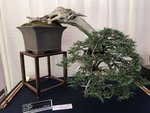***WARNING – GEEKERY AHEAD***
Alright guys, so I found a dendrology PhD thesis written in 1989 by a researcher here in Québec about a groupe of old thujas all from the same small area (a lake called "lac Duparquet"). The link is
here if you want to dust off your high school French

His main conclusions are as follows:
- The Abitibi region is south of James Bay, about 6-8 hours north of Montréal. It’s a heavily forested region with harsh climate (on average, only 64 consecutive frost free days per year). Very strong winds, heavy snow, you name it.
- Thujas grow in that region, albeit not in significant numbers (the northern limit for that species is 300 km north though of the lake, though). Most thujas in that region as in elsewhere live in moist organic soil, near lakes or on the shore directly
- The sample of the trees studied comprised 43 trees that are older than 500 years. Of these, only 5 came from moist sites (the "moist thujas"), and of these 5, the oldest stands at 583. The 38 others all came from dry sites (the oldest at the time of study was 908 years). The study mostly focuses on the "dry" thujas, most of which live on islands on the lake.
- These dry thuyas grow on islands without competition, on very dry rocky surfaces with very fast drainage, a steep inclination and in full sun. The researcher noticed that most of the old ones were growing facing the west (only one 500+ y.o. tree facing East). They get most of their water from spring and early summer rains, since the soil is frozen about 8-9 months a year.
- They have no real pests and fungal issues are not a climate in dry locations where they grow.
- Other traits of the island thuyas were low height, dead apical regions, very asymetrical growth, barkless portions of the trunk. Kind of the standard old yamadori stuff. He notices that the living cambial region of these trees is usually facing inland, so not towards the lake and the strong winds.
- The island thuyas, even the ones above 800 years, continue to produce cones and seeds.
- The research hypothesizes that the dry substrate they grow in severay limit the amount of foliage and cambial tissue the trees can produce each year, and that successive loss of apices allows the tree to reduce its need to transport water to the top of the tree, which furthers reduces the amount of water it needs to live. The author states many time that the 500+ y.o. thujas "maintain a very fine balance between photosynthetic and non-photosynthetic tissue"
- One big difference between the dry and the moist thujas was that the trunks of the moist ones tended to hollow out over time, whereas the dry ones would lose parts or most of their trunk, but they would rarely become hollow.
- The researcher actually draws amazing conclusions, because he says the core extracts from these dry thuyas reveal a ton of information on climate, and they can cross-referene information about very cold and harsh periods. The growth ring for 1440-1500, for example, signifies that the temperatures of that period got markedly colder, and this can be correlated with what other dendrologists have observed in the core of old trees in California.
- The author states that the yearly growth patterns on thujas (from the dendrological side of things) indicates that they like a lot of water in the spring, and that when July is very hot, growth is reduced. Foliage growth is over at the end of June in most years.

